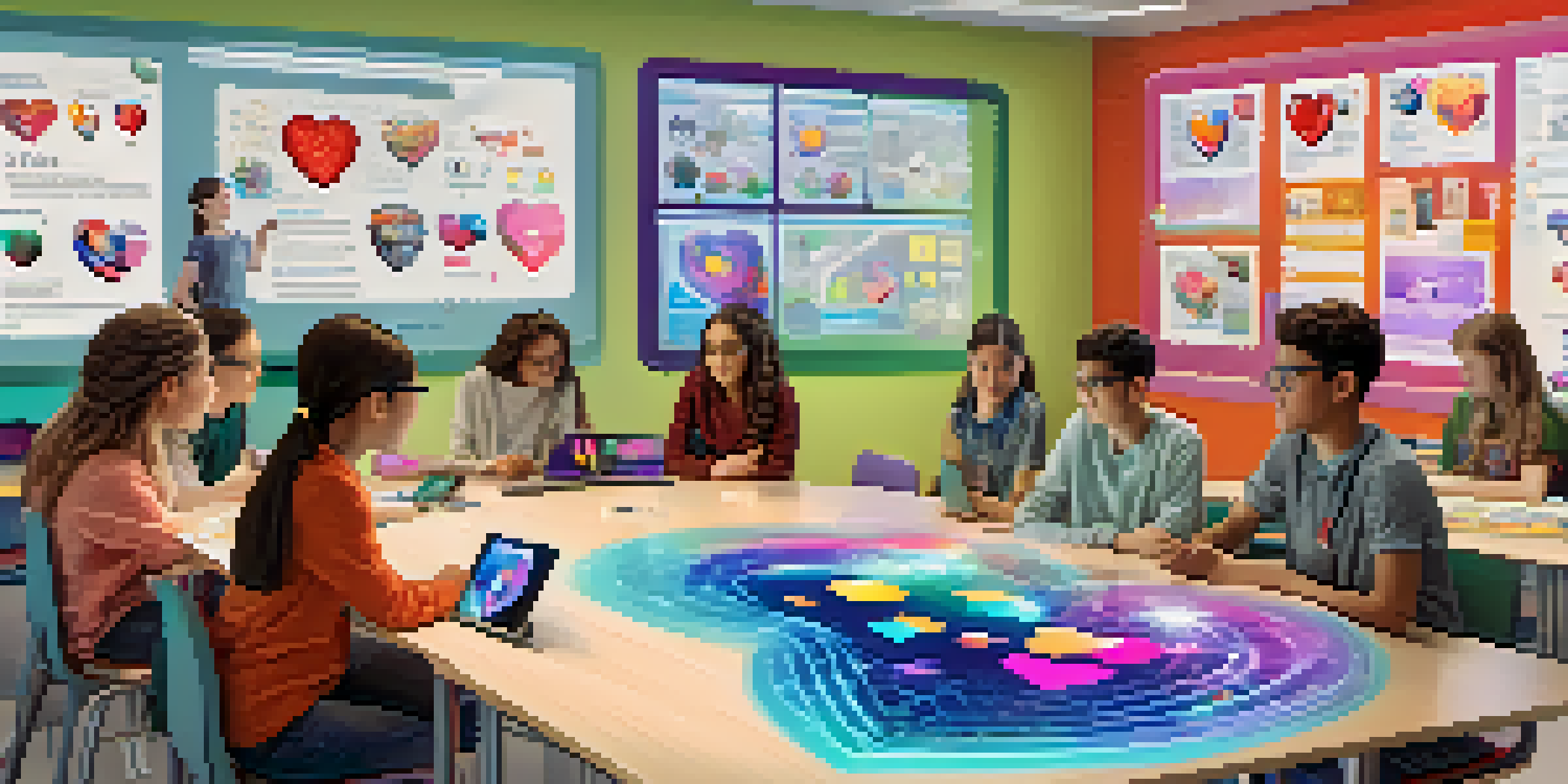Augmented Reality for Developing Emotional Intelligence in Students

Understanding Emotional Intelligence in Education
Emotional intelligence (EI) refers to the ability to recognize, understand, and manage our own emotions while also empathizing with others. In the context of education, EI is crucial as it helps students navigate social complexities and build meaningful relationships. Developing EI can lead to better academic performance and improved mental health, making it a vital focus area for educators and parents alike.
Emotional intelligence is the key to both personal and professional success.
For instance, a student with high emotional intelligence can better handle stress during exams, resolve conflicts with peers effectively, and demonstrate resilience in the face of challenges. By integrating emotional intelligence training into the curriculum, schools can foster a more supportive and understanding environment. This not only benefits individual students but also enhances the overall classroom atmosphere.
As we delve into the intersection of technology and emotional intelligence, it becomes clear that innovative tools can play a significant role in this developmental journey. Among these, augmented reality (AR) stands out as a powerful medium for creating immersive learning experiences that can resonate deeply with students.
What is Augmented Reality and How Does It Work?
Augmented reality is a technology that overlays digital information onto the real world, enriching our perception of our surroundings. It typically involves the use of devices like smartphones or AR glasses, which display virtual elements that users can interact with in real-time. This blend of the digital and physical worlds offers a unique way to enhance learning experiences.

Imagine a student studying biology who can see a 3D model of a heart beating right in front of them. This hands-on interaction can make complex subjects feel more tangible and relatable. By engaging multiple senses, AR not only captures attention but also aids in retention, making it an effective educational tool.
Emotional Intelligence Enhances Learning
Developing emotional intelligence in students can improve their academic performance and mental health.
Furthermore, AR can be utilized to create scenarios that promote emotional learning. For instance, students can step into simulated situations where they must navigate social interactions, allowing them to practice empathy and conflict resolution skills in a safe environment.
AR Applications for Enhancing Emotional Intelligence
There are various AR applications designed specifically to enhance emotional intelligence in students. Some programs allow students to visualize and analyze their emotions through interactive exercises, helping them to identify feelings and understand their triggers. For example, an app might depict different facial expressions in response to various scenarios, prompting students to discuss what emotions are being portrayed.
Technology is best when it brings people together.
Moreover, AR can simulate real-life situations where students must make decisions based on emotional cues. For instance, a role-playing scenario could involve a conflict between friends, allowing students to practice their negotiation skills and develop a deeper understanding of empathy. This practical approach reinforces the concepts of emotional intelligence in a memorable way.
Not only do these applications help students learn about emotions, but they also encourage self-reflection and personal growth. By experiencing emotions in a controlled AR setting, students can gain insights into their own behaviors and reactions, fostering a greater awareness of themselves and others.
Benefits of AR in Developing Emotional Intelligence
One significant benefit of using augmented reality in education is its ability to foster engagement among students. Traditional learning methods can sometimes feel monotonous, but AR transforms lessons into interactive experiences that capture students' attention. This engagement is crucial for effective learning, especially when it comes to complex subjects like emotional intelligence.
Additionally, AR promotes experiential learning, where students learn by doing rather than just listening or reading. This kind of learning is particularly effective for developing emotional intelligence, as students can practice real-world skills in a safe environment. The ability to make mistakes and learn from them in a simulated setting can build confidence.
AR Transforms Emotional Learning
Augmented reality provides immersive experiences that help students practice empathy and conflict resolution.
Finally, AR can cater to diverse learning styles. Visual learners may thrive with interactive graphics, while kinesthetic learners benefit from hands-on activities. By accommodating various preferences, AR ensures that all students have the opportunity to develop their emotional intelligence in a way that resonates with them.
Challenges and Considerations in Implementing AR
While the potential of augmented reality in education is promising, there are challenges that educators must consider. One primary concern is the accessibility of technology. Not all students may have access to the necessary devices, which can create disparities in learning opportunities. Addressing this issue is essential to ensure that all students benefit equally from AR experiences.
Moreover, educators need appropriate training to integrate AR effectively into their teaching strategies. Simply having the technology is not enough; teachers must understand how to use it to enhance emotional intelligence development. Professional development programs can help bridge this gap, equipping educators with the skills they need.
Finally, it’s important to balance technology use with traditional teaching methods. While AR offers exciting possibilities, it shouldn’t replace fundamental teaching approaches. A blended approach that combines AR with conventional methods can create a more holistic learning experience that maximizes student engagement and learning outcomes.
Future Perspectives: AR and Emotional Intelligence
Looking ahead, the integration of augmented reality in education is likely to expand, particularly in the realm of emotional intelligence. As technology advances, we can expect more sophisticated AR applications designed to address specific emotional learning needs. This evolution will provide educators with innovative tools to support students in developing crucial social skills.
Moreover, as AR becomes more mainstream, collaboration between tech developers and educators will be essential. By working together, they can create resources that align with educational standards while also meeting the diverse needs of students. This partnership has the potential to revolutionize how emotional intelligence is taught in schools.
Challenges in AR Adoption Persist
Accessibility of technology and the need for proper educator training are key challenges in implementing AR in education.
Ultimately, the goal is to create a future where emotional intelligence is prioritized in education, equipping students with the skills they need to thrive personally and professionally. With augmented reality leading the charge, we may be on the cusp of a transformative shift in how we approach emotional learning.
Conclusion: The Role of AR in Shaping Emotionally Intelligent Students
In conclusion, augmented reality presents a unique opportunity to enhance emotional intelligence in students. By creating immersive and interactive experiences, AR can help students understand their emotions and the emotions of others in a profound way. This not only aids in their academic success but also prepares them for the complexities of adult life.
As educators begin to embrace this technology, the potential for positive change is immense. By fostering emotional intelligence, we can cultivate a generation of empathetic, resilient, and socially aware individuals. This focus on emotional intelligence, supported by AR, can lead to healthier relationships and more harmonious communities.

As we move forward, it will be exciting to see how educational institutions harness the power of augmented reality to shape emotionally intelligent students. With the right resources and commitment, we can pave the way for a more emotionally aware future.